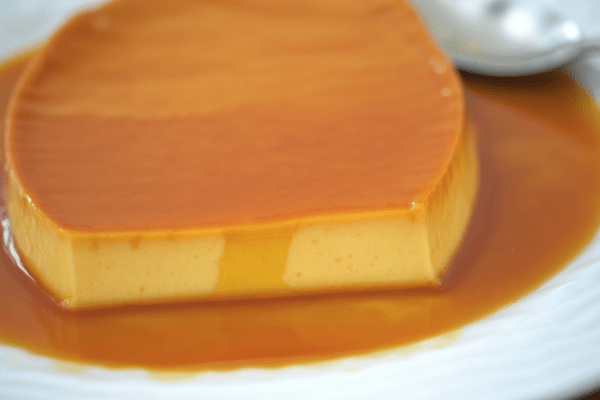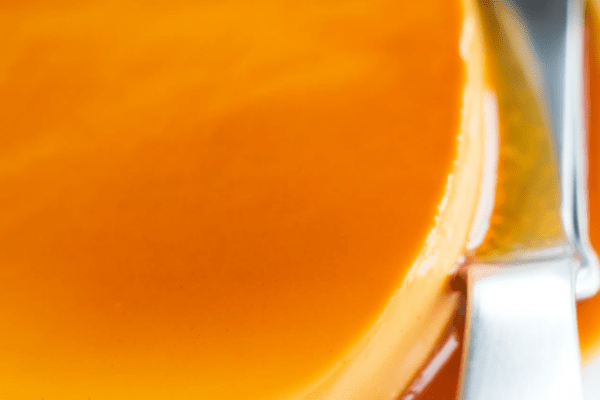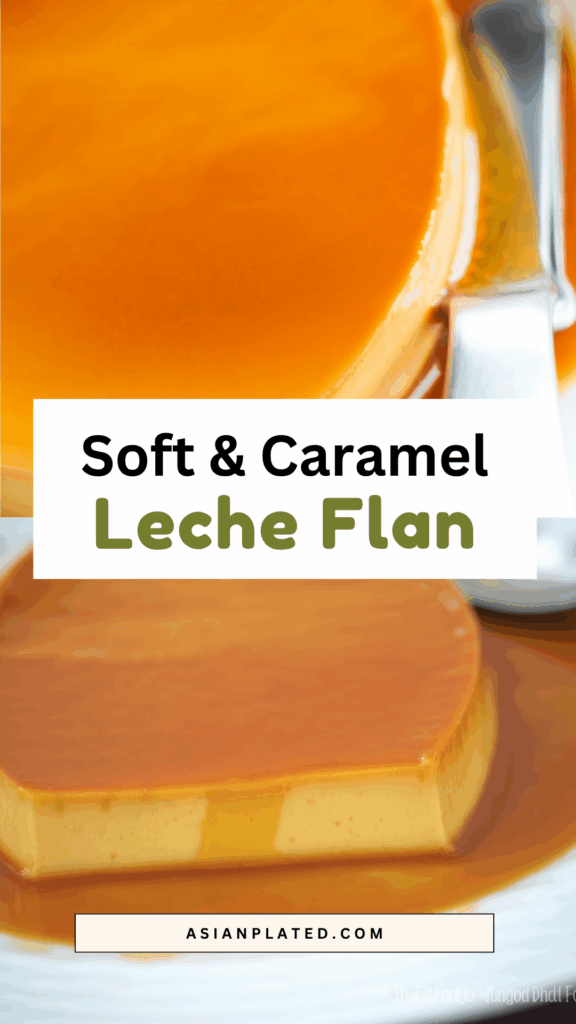Leche Flan is one of those desserts that always feels like home to me. It’s silky, sweet, and topped with that gorgeous layer of soft caramel that makes everyone’s eyes light up when you serve it. Think of it like crème caramel’s Filipino cousin—rich, creamy, and impossible to stop at one slice.

What I love about it, aside from the taste, is how easy it is to make ahead. It keeps beautifully in the fridge for days, so you can pull it out whenever you want to impress guests or treat yourself. It’s one of those staples I find myself making again and again, especially for family gatherings and holidays.
This is a Top Dessert in the Philippines
You can’t have a real Filipino celebration without Leche Flan on the table. It’s practically a requirement at Christmas, birthdays, fiestas—any big family gathering. Growing up, it was always the star of the dessert spread, and the dish everyone would hover around.
I still remember the flan my grandmother used to make when we lived in Las Piñas. Her version was so rich and creamy, with the perfect balance of sweetness. Everyone in the family would beg her to make it for special occasions, and she never disappointed.
I feel lucky these days because my wife is the Leche Flan master in our house. This recipe is actually hers. I like to joke that if I made it my way, it would probably come out more like Egg Pie. So I stick to eating and letting her do the magic.

What’s the Difference Between Leche Flan and Crème Caramel?
A lot of people ask me how Leche Flan compares to the European-style crème caramel. They’re definitely related, but there are some key differences.
Crème caramel uses cream, which gives it a lighter, more delicate texture. Leche Flan, on the other hand, relies on evaporated milk and sweetened condensed milk for that signature richness. The condensed milk doesn’t just add creaminess—it also ups the sweetness, giving it that classic Filipino taste.
I think that’s what makes Leche Flan so satisfying. It’s unapologetically rich and dense, and you know you’re eating something special. And of course, it’s always baked in those small metal molds called llaneras, which means you’re usually carefully slicing it up to share among eager family members. That ritual of portioning it out is part of the fun—though I’ve seen plenty of people go back for seconds and thirds if there’s extra.
Where Did Leche Flan Actually Come From?
Leche Flan has a pretty fascinating history. It dates back to the Spanish colonization of the Philippines in the 1500s. Spanish culture left its mark on our food in a big way, and this dessert is a perfect example.
One thing I always found interesting is that the Spanish missionaries used egg whites to help build churches—apparently, when mixed with lime, they made a strong adhesive. That meant there were a lot of leftover egg yolks to use up. Enter Leche Flan!
“Leche” means milk in Spanish, so the original name was “Leche de Flan,” or “milk flan.” Over time it got shortened to the simpler “Leche Flan” we know today.
Then the American era brought canned goods like evaporated and condensed milk to the Philippines, and that changed the recipe even more. Those ingredients are what give today’s Leche Flan its signature taste and velvety texture.
It’s amazing how something that started as a practical way to use leftover yolks turned into one of our most beloved desserts.

How to Cook Leche Flan
If you’ve never tried making Leche Flan at home, don’t worry—it’s much simpler than it seems.
Here’s how I do it in my own kitchen:
Start by beating the egg yolks until they’re smooth. I like to do this by hand with a fork for a bit of nostalgia, but you can use a hand mixer if you want to make it easier. Gradually add the condensed milk, fresh milk, and a splash of vanilla extract. Give it a good mix until everything is well combined. Set that aside while you make the caramel.
For the caramel, sprinkle sugar directly into your llanera or whatever mold you’re using. Heat it gently over the stovetop while wearing oven mitts (trust me, hot caramel is no joke). Watch carefully as the sugar melts and turns that lovely golden color. Once it’s ready, tilt the mold to spread the caramel evenly.
Then pour in the egg mixture slowly. I like to strain it through a fine sieve first to get it extra smooth and silky. Cover the mold tightly with foil.
Now for the cooking part. Traditionally, I steam the molds for about 30 minutes until the custard sets. The hardest part is resisting the urge to eat it right away! I usually let it cool to room temperature, then chill it in the fridge. Cold Leche Flan is just unbeatable.
Leche Flan

If there’s one dessert that always brings back memories of family celebrations and Sunday lunches, it’s Leche Flan.
Ingredients
- 10 egg yolks
- 1 (14 oz) can of condensed milk
- 1 cup fresh or evaporated milk
- 1 cup granulated sugar
- 1 teaspoon vanilla extract
Instructions
- Prepare the Custard MixtureStart by separating the yolks from the whites — we’ll only be using the yolks for that signature richness. Place them in a large mixing bowl and gently beat using a fork or whisk until smooth.
- Pour in the condensed milk and stir until fully combined. Next, add the fresh milk and a splash of vanilla extract. Mix everything together until it’s silky and well blended. Set aside.
- Make the CaramelPlace your llanera (traditional flan mold) or small round baking pans over low heat on the stove. Sprinkle in the granulated sugar and gently heat until it melts and turns into a golden caramel. Swirl the mold carefully to coat the bottom evenly. Be cautious — hot sugar can burn quickly.
- Combine and SteamLet the caramel cool and set for about 5 minutes. Then, pour the custard mixture over the caramel layer. Cover the mold tightly with aluminum foil.
- Set up your steamer and steam the flan for 30 to 35 minutes. You’ll know it’s done when the flan is set but still has a slight jiggle in the center.
- Chill and ServeOnce cooked, remove the mold from the steamer and let it cool to room temperature. Then transfer it to the refrigerator and chill for a few hours — overnight is even better.
- To serve, run a thin knife around the edge of the flan, place a plate on top of the mold, and flip it over to release that beautiful caramel top.
Nutrition Information:
Yield: 6 Serving Size: 1Amount Per Serving: Calories: 299Total Fat: 11gSaturated Fat: 5gTrans Fat: 0gUnsaturated Fat: 6gCholesterol: 322mgSodium: 67mgCarbohydrates: 42gFiber: 0gSugar: 41gProtein: 8g
Asianplated.com, occasionally offers nutritional information for recipes contained on this site. This information is provided as a courtesy and is an estimate only. This information comes from online calculators. Although allchickenrecipes.com attempts to provide accurate nutritional information, these figures are only estimates.
What Are Some Related Recipes I Could Cook?
Oven-Baked Leche Flan
Sometimes I make the oven-baked version, especially if I’m making a big batch for a party. The nice thing is you can use any oven-safe dish—cake pans, ramekins, whatever you have on hand. The texture stays smooth and creamy if you use a water bath. That step helps it cook evenly without cracking.
Leche Puto
Another favorite is Leche Puto—a fusion of two beloved Filipino treats. Imagine the sweet creaminess of Leche Flan sitting on top of fluffy steamed rice cakes. It’s the kind of thing that surprises guests in the best way. It’s easy to make and perfect for potlucks or family merienda.
Leche Flan is the kind of dessert that connects generations. Every family seems to have their own version, with little tweaks and secrets. But no matter how you make it, there’s something special about serving it up and seeing everyone’s faces light up.
Try other recipes:

